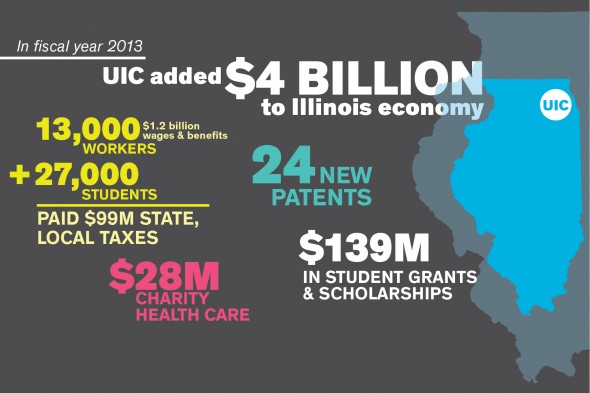UIC’s benefit to Illinois: $4 billion per year
The University of Illinois at Chicago — Chicago’s largest university with nearly 28,000 students — added $4 billion to the Illinois economy in fiscal 2013, according to a report prepared by the UIC Center for Urban Economic Development.
The center’s researchers measured UIC’s broad impact due to UIC’s educating Illinois residents; its direct contribution through employment and to the tax base; and other campus endeavors that advance economic development or equity.
“Economic impact” refers to the added economic value made possible by virtue of UIC’s existence – the number of jobs it created, the value of the goods and services it generated, the amount by which its employees were compensated, and the amount of state and local taxes those employees paid in fiscal 2013.
 Economic impact through education
Economic impact through education
Nearly $3 billion of UIC’s annual economic impact consists of higher earnings by UIC graduates who work in Illinois and earn higher incomes than they would without a degree. In fiscal 2013, UIC granted degrees to more than 3,800 undergraduates, 2,500 graduates and 600 professional students.
Among health care professionals practicing in Illinois, UIC estimates graduating 17 percent of the physicians, 44 percent of the dentists, 33 percent of the pharmacists, and 5 percent of the nurses.
Overall, about 70 percent of UIC graduates remain in Illinois after graduating, enhancing the state’s economy. The university also attracts international and out-of-state residents, many of whom remain in Illinois.
Economic contribution through employees’ compensation and taxes
In 2013, UIC employed 13,361 in full-time jobs, from support staff to brain surgeons and nuclear physicists. The university paid $1.2 billion in wages and benefits.
The 12,492 UIC employees living in Illinois earned $1.1 billion, and UIC employees and students paid $99 million in income, sales and property taxes to the state and local governments.
UIC also paid $803 million to contractors, most of them Illinois-based businesses, for services and supplies, including capital expenditures.
Other economic benefits
![research_funding[1]](http://today.uic.edu/wp-content/uploads/2015/05/research_funding1-390x206.png) UIC provided $139 million in grants and scholarships to students. Much of this aid is need-based, as half of UIC students are eligible for Pell grants and 43 percent are eligible for Monetary Award Program (MAP) grants.
UIC provided $139 million in grants and scholarships to students. Much of this aid is need-based, as half of UIC students are eligible for Pell grants and 43 percent are eligible for Monetary Award Program (MAP) grants.
UIC conducted $267 million of sponsored research during fiscal 2013, including $228 million funded by the federal government.
The University of Illinois Hospital & Health Sciences System provided $28 million in charity care.
UIC’s Office of Technology Management led 24 patents to issuance and generated more than $20 million in royalties and fees in fiscal 2013.
“UIC is one of only four universities in Illinois classified as Carnegie 1 — meaning very high research — universities, along with UI at Urbana-Champaign, Northwestern University, and the University of Chicago. As such, it’s a critical engine of economic growth in Chicago, and its impact extends throughout Illinois and beyond,” said Michael Pagano, dean of the College of Urban Planning and Public Affairs.
The Center for Urban Economic Development in the UIC College of Urban Planning and Public Affairs conducts research, policy analysis, and evaluation on urban and regional economic and workforce development issues.

